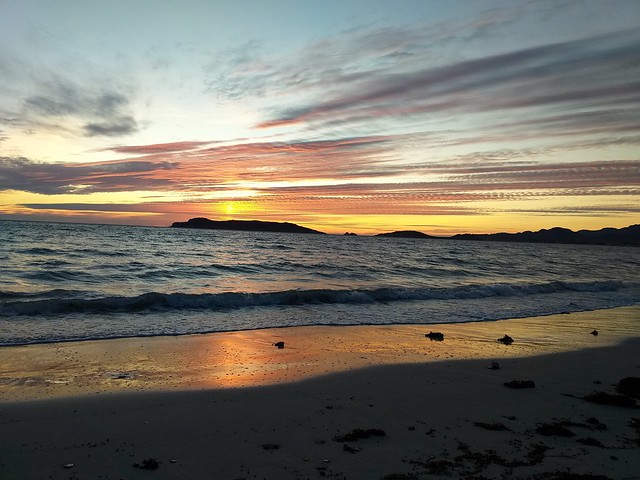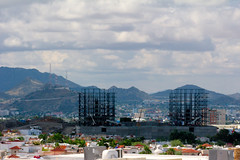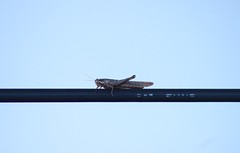Sonora
Sonora (Spanish: [soˈnoɾa]), officially Estado Libre y Soberano de Sonora (English: Free and Sovereign State of Sonora), is one of the 31 states which, along with Mexico City, comprise the Federal Entities of Mexico. The state is divided into 72 municipalities; the capital (and largest) city of which being Hermosillo, located in the center of the state. Other large cities include Ciudad Obregón, Nogales (on the Mexico-United States border), San Luis Río Colorado, and Navojoa.
Sonora is bordered by the states of Chihuahua to the east, Baja California to the northwest and Sinaloa to the south. To the north, it shares the U.S.–Mexico border primarily with the state of Arizona with a small length with New Mexico, and on the west has a significant share of the coastline of the Gulf of California.
Sonora's natural geography is divided into three parts: the Sierra Madre Occidental in the east of the state; plains and rolling hills in the center; and the coast on the Gulf of California. It is primarily arid or semiarid deserts and grasslands, with only the highest elevations having sufficient rainfall to support other types of vegetation.
Sonora is home to eight indigenous peoples, including the Mayo, the O’odham, the Yaqui, and Seri. The state has been economically important for its agriculture, livestock (especially beef), and mining since the colonial period, and for its status as a border state since the Mexican–American War. With the Gadsden Purchase, Sonora lost more than a quarter of its territory. From the 20th century to the present, industry, tourism, and agribusiness have dominated the economy, attracting migration from other parts of Mexico.
Etymology
Several theories exist as to the origin of the name "Sonora". One theory states that the name was derived from Nuestra Señora, the name given to the territory when Diego de Guzmán crossed the Yaqui River on the day of Nuestra Señora del Rosario ("Our Lady of the Rosary"), which falls on with the pronunciation possibly changing because none of the indigenous languages of the area have the ñ sound. Another theory states that Álvar Núñez Cabeza de Vaca and his companions, who had wrecked off the Florida coast and made their way across the continent, were forced to cross the arid state from north to south, carrying an image of Nuestra Señora de las Angustias ("Our Lady of Anguish") on a cloth. They encountered the Opata, who could not pronounce Señora, instead saying Senora or Sonora. A third theory, written by Father Cristóbal de Cañas in 1730, states that the name comes from the word for a natural water well, sonot, which the Spaniards eventually modified to "Sonora". The first record of the name Sonora comes from explorer Francisco Vázquez de Coronado, who passed through the state in 1540 and called part of the area the Valle de la Sonora. Francisco de Ibarra also traveled through the area in 1567 and referred to the Valles de Señora. The literal meaning of "sonora" in Spanish is a feminine form of the adjective "sonoro" meaning "sonorous" or "loud."
History
Pre-Hispanic period
Evidence of human existence in the state dates back over 10,000 years, with some of the best-known remains at the San Dieguito complex in the El Pinacate Desert. The first humans were nomadic hunter gatherers who used tools made from stones, seashells, and wood. During much of the prehistoric period, the environmental conditions were less severe than they are today, with similar but more dense vegetation spread over a wider area.
The oldest Clovis culture site in North America is believed to be El Fin del Mundo in northwestern Sonora. It was discovered during a 2007 survey. It features occupation dating around 13,390 calibrated years BP. In 2011, remains of Gomphothere were found; the evidence suggests that humans did in fact kill two of them here.
Agriculture first appeared around and in the river valleys. Remains of ceramics have been found dating from with diversification from 800 and Between 1100 and 1350, the region had socially complex small villages with well-developed trade networks. The lowland central coast, however, seems never truly to have adopted agriculture. Because Sonora and much of the northwest does not share many of the cultural traits of that area, it is not considered part of Mesoamerica. Though evidence exists of trade between the peoples of Sonora and Mesoamerica, Guasave in Sinaloa is the most north-westerly point considered Mesoamerican.
Three archaeological cultures developed in the low, flat areas of the state near the coast: the Trincheras tradition, the Huatabampo tradition, and the Central Coast tradition. The Trincheras tradition is dated to between 750 and 1450 CE and mostly known from sites in the Altar, Magdalena, and Concepción valleys, but its range extended from the Gulf of California into northern Sonora. The tradition is named after trenches found in a number of sites, the best known of which is the Cerro de Trincheras. The Huatabampo tradition is centered south of the Trincheras along the coast, with sites along extinct lagoons, estuaries, and river valleys. This tradition has a distinctive ceramic complex. Huatabampo culture shows similarities with the Chametla to the south and the Hohokam to the north. This probably ended around 1000 CE. Unlike the other two traditions, the Central Coast remained a hunter-gatherer culture, as the area lacks the resources for agriculture.
The higher elevations of the state were dominated by the Casas Grandes and Río Sonora tradition. The Río Sonora culture is located in central Sonora from the border area to modern Sinaloa. A beginning date for this culture has not been determined but it probably disappeared by the early 14th century. The Casas Grandes tradition in Sonora was an extension of the Río Sonora tradition based in the modern state of Chihuahua, which exerted its influence down to parts of the Sonoran coast.
Climatic changes in the middle of the 15th century resulted in the increased desertification of northwest Mexico in general. This is the probable cause for the drastic decrease in the number and size of settlements starting around this time. The peoples that remained in the area reverted to a less complex social organization and lifestyle. Whatever socially complex organization existed in Sonora before the Spaniards was long gone by the 16th century.
Viceroyalty of New Spain
Little reliable information remains about the area in the 16th century following the Spanish conquest of the Aztec Empire. Some state that the first Spanish settlement was founded by Álvar Núñez Cabeza de Vaca in 1530, near Huépac. Others state that Francisco Vásquez de Coronado founded a village on the edge of the Yaqui River in 1540 on his way north. Another source states that the first Spanish presence was not until 1614, by missionaries such as Pedro Méndez and Pérez de Rivas, working with the Mayo. Unlike in central Mexico, no central social or economic centralization occurred in the Sonora area, given the collapse of population centers in the 15th century. The five traditions of the past had broken down to a number of fractured ethnicities. No empire or other system was present for the Spaniards to co-opt for domination purposes. In addition, the Yaqui people resisted European intrusion on their lands, effectively keeping the Spaniards out of their area until the 17th century. While exploration of the area happened through the expeditions of the 16th century, significant permanent Spanish settlement did not become possible until the establishment of the mission system.
Jesuit priests began to work in Sonora in the 1610s in the lowlands near the coast. Originally, these missionaries worked out a peaceful compromise with the 30,000 Yaquis allowing for the establishment of more than fifty mission settlements in the Sonora river valleys. This broke down when the Jesuits opposed the native shamanic religious tradition. The Opata were more receptive to the missionaries and allied with them. After this, the Jesuits began to move into Pima and Tohono O'odham territories. Spanish exploration and missionary work was sufficient to consider the territory part of New Spain. An agreement between General Pedro de Perea and the viceroy of New Spain resulted in the general shaping of the province, initially called Nueva Navarra in 1637, but renamed Sonora in 1648.
The most famous missionary of Sonora, as well as much of what is now the American Southwest, was Eusebio Kino. He arrived in Sonora in 1687 and started missionary work in the Pimería Alta area of Sonora and Arizona. He began his first mission at Cucurpe, then established churches and missions in other villages such as Los Remedios, Imuris, Magdalena, Cocóspera, San Ignacio, Tubutama and Caborca. To develop an economy for the natives, Father Kino also taught them European farming techniques.
The initial attraction of Sonora for the Spaniards was its fertile farmlands along the river valleys and its position as part of a corridor linking the central Mexican highlands around Mexico City up the Pacific coast and on into Arizona and points north. This corridor still exists in the form of Federal Highway 15. After the establishment of the mission system, Spanish colonists followed. Indigenous response was a mixture of accommodation and violence, as different strategies were employed by different groups at different times. The sporadic violence, which would continue throughout the colonial period, resulted in the Spanish building presidios and other fortifications to protect missions and Spanish settlements. While the colonization process was not especially violent, the impact on the indigenous of the area was severe, as it almost completely disrupted their formerly very independent lives, forcing them to conform to an alien centralized system. One consequence of this was alcoholism among the native peoples.
In 1691, what are now the states of Sonora and Sinaloa were joined into an entity call…
Looking for places related to Sonora?
Those are other destinations to find places related to Sonora:
























